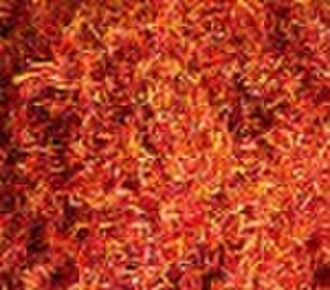Catalog
-
Catalog
- Agriculture
- Apparel
- Automobiles & Motorcycles
- Beauty & Personal Care
- Business Services
- Chemicals
- Construction & Real Estate
- Consumer Electronics
- Electrical Equipment & Supplies
- Electronic Components & Supplies
- Energy
- Environment
- Excess Inventory
- Fashion Accessories
- Food & Beverage
- Furniture
- Gifts & Crafts
- Hardware
- Health & Medical
- Home & Garden
- Home Appliances
- Lights & Lighting
- Luggage, Bags & Cases
- Machinery, Hardware & Tools
- Measurement & Analysis Instruments
- Mechanical Parts & Fabrication Services
- Minerals & Metallurgy
- Office & School Supplies
- Packaging & Printing
- Rubber & Plastics
- Security & Protection
- Service Equipment
- Shoes & Accessories
- Sports & Entertainment
- Telecommunications
- Textiles & Leather Products
- Timepieces, Jewelry, Eyewear
- Tools
- Toys & Hobbies
- Transportation
Filters
Search
003 herbal medicine

Ye Li
Contact person
Basic Information
Safflower is an annual herb whose botanical name is Carthamus tinctorius. It is a member of the family. It has long, leaves and yellow or reddish flowers on a stiff, upright stem. The seeds produce edible oil. Safflower grows to a height of about 3 ft (1 m) in poor, dry soils in full sun. The origins of this plant are not clear, although some herbalists suggest the basin of the . Today safflower grows wild in , northwest India, and . It has also spread to the Far East and North America. Safflower is cultivated extensively both as an herb and as a food crop. General Use Safflower flower has been used in for thousands of years. It is used to treat menstrual disorders. Safflower flower is an emmenagogue, meaning that it is given to bring on . Safflower is also used to treat menstrual , to firm up the uterus after , to ease stiffness and pain in the joints, and sometimes also to treat trauma to the abdomen. According to traditional Chinese usage, safflower flower is a blood regulator; that is, it invigorates and harmonizes the blood and dissolves . Safflower is said to have a warm nature and a pungent taste. Chinese practitioners use in tui na massage. Safflower flowers are also used to treat such childhood problems as , fevers, and skin . Applied externally, safflower flower is used to cleanse . Interestingly, on the other side of the world, North Americans used safflower flower in the nineteenth century in much the same way as the Chinese—to bring on menstruation and to treat . They also used it to induce sweating. Safflower seeds can be pressed to produce edible oil. The unpurified form of this oil is used as a laxative or to cleanse the bowels. Processed safflower oil does not have laxative properties. The processed oil is used extensively in cooking and for making margarine and salad dressings. The oil is also used in paints and varnishes, and is burned for lighting where electricity is unavailable. Safflower has other non-medicinal uses. Its flowers produce a dye that in times past was used for dyeing silk yellow or red. Today, chemical dyes have largely replaced safflower dye. The flowers were also dried and ground together with finely powdered to produce cosmetic rouge. Safflower is an annual herb whose botanical name is Carthamus tinctorius. It is a member of the family. It has long, leaves and yellow or reddish flowers on a stiff, upright stem. The seeds produce edible oil. Safflower grows to a height of about 3 ft (1 m) in poor, dry soils in full sun. The origins of this plant are not clear, although some herbalists suggest the basin of the . Today safflower grows wild in , northwest India, and . It has also spread to the Far East and North America. Safflower is cultivated extensively both as an herb and as a food crop. General UseSafflower flower has been used in for thousands of years. It is used to treat menstrual disorders. Safflower flower is an emmenagogue, meaning that it is given to bring on . Safflower is also used to treat menstrual , to firm up the uterus after , to ease stiffness and pain in the joints, and sometimes also to treat trauma to the abdomen. According to traditional Chinese usage, safflower flower is a blood regulator; that is, it invigorates and harmonizes the blood and dissolves . Safflower is said to have a warm nature and a pungent taste. Chinese practitioners use in tui na massage. Safflower flowers are also used to treat such childhood problems as , fevers, and skin . Applied externally, safflower flower is used to cleanse . Interestingly, on the other side of the world, North Americans used safflower flower in the nineteenth century in much the same way as the Chinese—to bring on menstruation and to treat . They also used it to induce sweating. Safflower seeds can be pressed to produce edible oil. The unpurified form of this oil is used as a laxative or to cleanse the bowels. Processed safflower oil does not have laxative properties. The processed oil is used extensively in cooking and for making margarine and salad dressings. The oil is also used in paints and varnishes, and is burned for lighting where electricity is unavailable. Safflower has other non-medicinal uses. Its flowers produce a dye that in times past was used for dyeing silk yellow or red. Today, chemical dyes have largely replaced safflower dye. The flowers were also dried and ground together with finely powdered to produce cosmetic rouge.
Delivery terms and packaging
Packaging Detail: as to the customer's requirement. Delivery Detail: 30 days after SC signed
Port: Beijing,Shanghai
Payment term
Letter of credit
Telegraphic transfer
-
Payment Methods
We accept:









